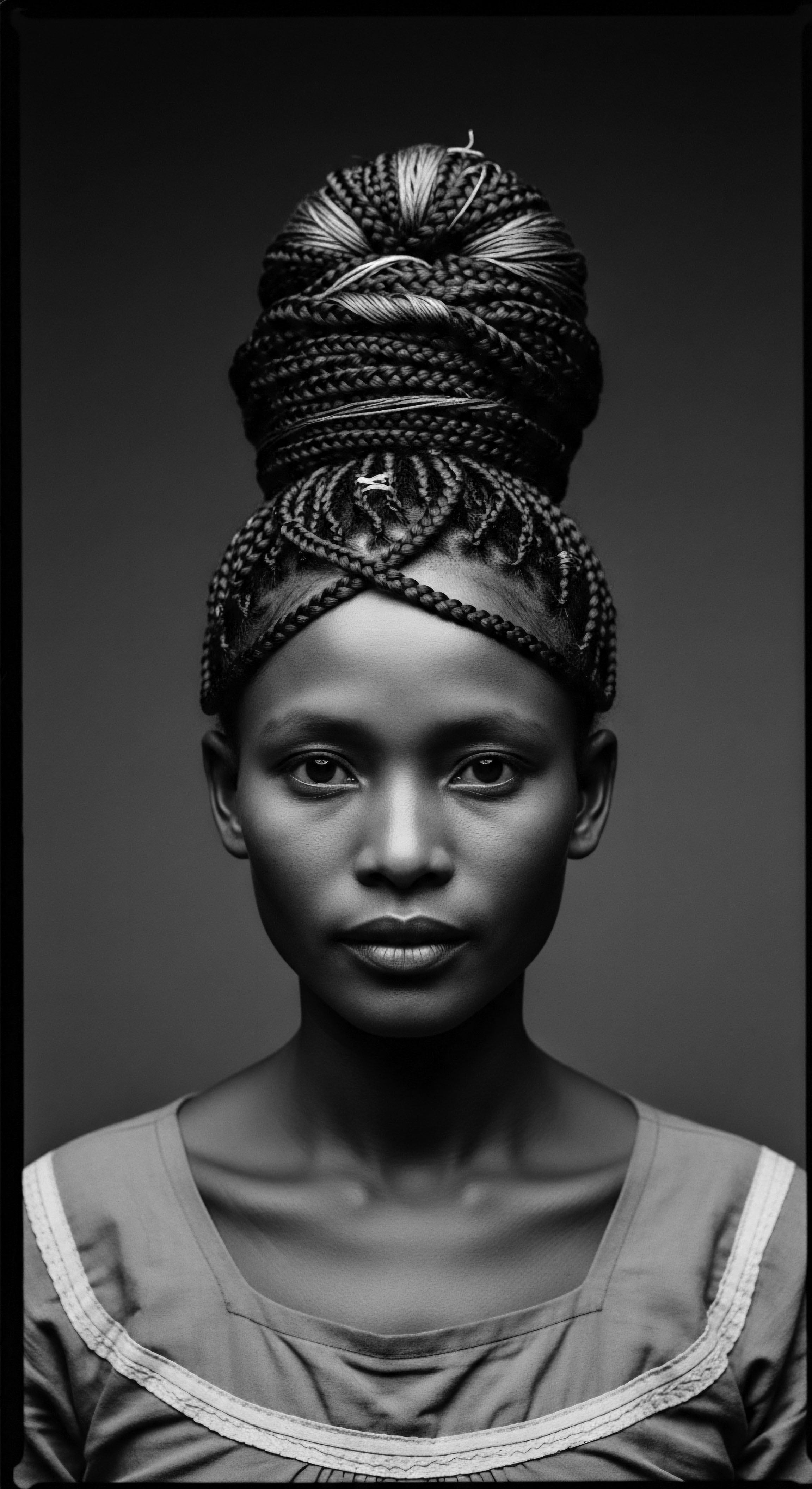
Roots
Imagine for a moment a time when the very strands that spring from your scalp carried the weight of your lineage, the whispers of your ancestors, and the vibrant stories of your community. For women of African descent, particularly those whose heritage traversed the Middle Passage, hair was never simply an adornment. It was a living archive, a scroll of identity unfurling with each coil, each braid, each twist. It was a language, spoken without uttering a single sound, conveying social standing, marital status, spiritual connection, and even tribal affiliation.
Then arrived the year 1786 in Spanish colonial Louisiana, and with it, the Tignon Laws. These mandates, issued by Governor Esteban Rodríguez Miró, demanded that free women of color in New Orleans conceal their hair with a headscarf, a ‘tignon’. This governmental decree sought to diminish the visible splendor and social standing of these women, whose elaborate hairstyles and vibrant self-expression were seen as threatening to the existing racial hierarchy and the perceived social order. It was an attempt to strip away a potent symbol of their inherent dignity and connection to a rich, ancestral heritage.
How, then, did such a restrictive measure redefine hair heritage? The laws did not erase this heritage; rather, they forced its reinvention, its quiet persistence, and its eventual re-emergence as a profound statement of selfhood and resistance. The story of the Tignon Laws offers a powerful lens through which to comprehend the enduring spirit of textured hair heritage in the face of systemic attempts at suppression.

The Language of Ancestral Strands
Before the shadow of the Tignon Laws stretched across New Orleans, hair in many African societies served as a sophisticated form of communication. From the intricate cornrows of the Wolof to the symbolic braids of the Yoruba, hairstyles conveyed complex messages. A particular coiffure might signify age, indicating a rite of passage, or disclose a woman’s marital status.
Certain styles were reserved for ceremonies, others for daily life, each holding its unique place in the community’s collective understanding. Hairdressers, often revered figures, spent hours, sometimes days, crafting these elaborate styles, making the process a communal activity that strengthened social bonds.
Hair, in ancient African communities, was a living lexicon, communicating identity, status, and spiritual connection without need for words.
This deep connection to hair as a cultural identifier traveled with enslaved Africans across the Atlantic. Despite the brutal conditions of the transatlantic slave trade, where heads were often shaved upon capture as a dehumanizing act of cultural erasure, the memory and practice of ancestral hair traditions persisted. Enslaved Africans carried the knowledge of their hair heritage, adapting traditional braiding patterns, for instance, sometimes even using them to map escape routes or conceal seeds for survival. This resilience laid the foundation for the vibrant hair traditions that would later flourish in the diaspora, even under duress.

Hair Biology and Its Cultural Reflections
The physical characteristics of textured hair also play a role in its heritage. Textured hair, particularly Afro-textured hair, is distinct. Its unique coiling pattern, often described as having an elliptical cross-section and a retro-curvature at the hair bulb, makes it susceptible to damage if not handled with care. These biological realities, passed down through genetic heritage, meant that ancestral practices often prioritized moisture, protection, and gentle manipulation.
The science behind hair texture, while a modern field of study, echoes ancestral wisdom concerning appropriate care. Our genes dictate the shape of our hair follicles, which in turn determines whether hair grows straight, wavy, or in tightly wound curls. This genetic coding, influencing disulfide bonds within keratin, directly relates to the hair’s shape and strength. Understanding this intrinsic structure allows us to appreciate how traditional methods of care were often intuitively aligned with the hair’s biological needs, ensuring its health and vitality across generations.
- Folkloric Practices ❉ Many African communities, like the Himba tribe, used mixtures of natural substances, such as clay and cow fat, not only for styling but also for sun protection and detangling.
- Communal Grooming ❉ Hairdressing was a significant social ritual, where knowledge of intricate styles and care practices was shared and passed down among women, fostering community bonds.
- Protective Adornments ❉ Beads, cowrie shells, and precious metals were often incorporated into hairstyles, serving as both artistic embellishment and symbolic protection, reflecting wealth or spiritual beliefs.

Ritual
The imposition of the Tignon Laws in 1786 sought to dismantle a visible expression of heritage, but they failed to account for the ingenious spirit of adaptation inherent in human culture. These laws, ostensibly about dress code and social order, served a darker purpose ❉ to visually mark free women of color as subordinate, linking them to the enslaved population and diminishing their allure in the eyes of white men. Yet, what began as a tool of oppression quickly transformed into a powerful emblem of defiance.
The requirement to cover their hair with a tignon, a simple scarf, was met not with submission, but with a vibrant reimagining. Women used their creative energy to craft elaborate, ornate headwraps from luxurious fabrics, adorning them with jewels, feathers, and ribbons. This act of defiance was a profound redefinition of hair heritage, turning a symbol of supposed inferiority into a striking statement of personal style, wealth, and cultural pride. This adaptation became an enduring symbol of resistance and a celebration of African heritage, continuing long after the laws ceased to be enforced.

Adapting to the Mandate, Reinventing Self
The Tignon Laws were a direct assault on the pre-existing cultural significance of hair for Black women in Louisiana. Prior to these laws, their elaborate hairstyles, often adorned with feathers and jewels, were a source of pride and a marker of status, sometimes even attracting white suitors. Governor Miró’s decree explicitly aimed to curb this visible competition with white women and reinforce racial stratification.
The law stated that “Negras Mulatas, y quarteronas can no longer have feathers nor jewelry in their hair. instead, they must wear plain headscarves or panuelos, if they are of higher status, as they have been accustomed to.”
The Tignon Laws intended to suppress, but instead sparked an artistic rebellion, transforming mandated head coverings into symbols of vibrant resistance and identity.
This seemingly simple regulation carried weighty implications. It weaponized hair, attempting to control, hypersexualize, and de-feminize Black women for centuries. However, the women of New Orleans responded with an unexpected flourishing of creativity. They meticulously tied their tignons, transforming plain handkerchiefs into intricate, sculptural designs.
This act was not merely about compliance; it was about asserting agency, reclaiming beauty, and broadcasting a heritage that refused to be silenced. The tignon, initially a badge of perceived inferiority, became a mark of distinction, a wearable art form that subtly yet powerfully undermined the law’s intent.

How Did Styling Practices Transform Amidst Suppression?
Traditional African styling, with its emphasis on intricate braids, twists, and adornments, always held meaning. With the Tignon Laws, the canvas for this expression shifted from exposed hair to the headwrap itself. This created a new avenue for artistic expression and the preservation of cultural aesthetics. While hair underneath the tignon might have been kept in simpler protective styles, the outward display of the wrap became a testament to the community’s ingenuity and deep aesthetic sensibilities.
The materials chosen for these headwraps were significant too. Women who could afford it used expensive silks, velvets, and other rich fabrics. This use of high-quality materials served as a quiet demonstration of their economic standing, directly contradicting the law’s intention to lower their perceived status.
This resistance was not always overt; it resided in the exquisite folds, the carefully selected colors, and the subtle yet powerful message of continued self-worth and cultural pride. This historical example illustrates how the ritual of dressing hair, even when forced into concealment, became a profound act of preserving identity within the broader textured hair heritage.
The legacy of the Tignon Laws persists in the continued policing of Black women’s hair today, yet the spirit of creative resistance remains a powerful counter-narrative. The Tignon is a historical example of how Black women have used style and personal presentation as a tool against oppression and for the celebration of African heritage.
| Traditional African Hair Expression Direct display of intricate braids, twists, and adornments. |
| Impact of Tignon Laws Mandated concealment of hair, intended to symbolize lower social status. |
| Redefinition and Resistance Headwraps (tignons) became a new canvas for elaborate styling, fabric choice, and embellishment. |
| Traditional African Hair Expression Hair as a direct indicator of social status, marital status, and tribal identity. |
| Impact of Tignon Laws Attempt to strip away visual markers of free Black women's status and attractiveness. |
| Redefinition and Resistance Tignons transformed into markers of beauty, wealth, and creativity, subverting the law's intent. |
| Traditional African Hair Expression Communal hair dressing as a bond-strengthening ritual. |
| Impact of Tignon Laws Forced public conformity shifted private acts of hair care and styling. |
| Redefinition and Resistance Shared defiance in tignon styling fostered solidarity and cultural continuity among women. |
| Traditional African Hair Expression The Tignon Laws, meant to suppress, ultimately highlighted the enduring creativity and resilience embedded within textured hair heritage. |

Relay
The narrative of the Tignon Laws transcends a singular historical event. It serves as a stark illustration of how political systems weaponize appearance, particularly hair, to enforce racial hierarchies and control identity. Yet, the story also relays a testament to the unbreakable spirit of textured hair heritage. It speaks to the continuous struggle for self-definition and the profound ways in which communities preserve their ancestral connections even when faced with direct legislative assault.
In the context of the 18th-century Louisiana, Governor Miró’s motivations were clear ❉ to control free women of color who were seen as too elegant and too competitive with white women for social status. Virginia M. Gould, a historian, notes that the laws were specifically intended to “return the free women of color, visibly and symbolically, to the subordinate and inferior status associated with slavery” (Byrd & Tharps, 2014). This direct link between hair, appearance, and social control is a recurring pattern throughout the history of Black identity in the diaspora.

How Did Hair Become a Political Canvas?
Hair has always been a political statement for Black communities. From ancient African societies, where coiffures communicated status and affiliation, to the present day, where natural hairstyles remain symbols of pride and resistance, hair has embodied identity. The Tignon Laws represent a critical historical juncture where this inherent cultural significance was directly confronted by colonial power.
The decision to mandate head coverings for free Black women, regardless of their status, was not merely about modesty or fashion. It was a deliberate act of visual subjugation.
The fact that free women of color in New Orleans possessed economic and social mobility was perceived as a threat. Their hairstyles, often as elaborate and adorned as those of white women, blurred the rigid racial lines colonial society sought to maintain. By forcing these women to cover their hair, the authorities aimed to erase this visual challenge, to clearly delineate racial boundaries, and to deny their inherent beauty and status. This particular moment highlights how external forces sought to redefine hair heritage by attempting to strip it of its expressive power, compelling an internal fortitude of resistance.
The Tignon Laws underscore hair’s enduring role as a political battleground, where personal expression and ancestral heritage faced oppressive legislative attempts.

What Was the Enduring Impact of the Tignon Laws on Identity?
While the Tignon Laws were formally rescinded after the Louisiana Purchase in 1803, their impact lingered. The practice of head wrapping, however, did not disappear. It continued as a symbol of Black women’s resistance, cultural heritage, and fashion.
This persistent adoption of the tignon, even after it was no longer legally required, speaks volumes about the community’s refusal to let external oppression dictate their self-perception. It became a chosen expression of identity, a deliberate act of reclaiming a heritage that had been attacked.
This historical example serves as a poignant case study of resistance through aesthetic means. The women of New Orleans leveraged their artistry and collective spirit to turn a symbol of degradation into one of dignity. This phenomenon, where a community transforms an oppressive tool into an emblem of their enduring strength, speaks to a deeply rooted heritage of resilience within Black and mixed-race experiences. It illustrates how the battle over hair is never simply about appearance; it is profoundly about autonomy, memory, and the continuous assertion of identity against forces that seek to diminish it.
- Legal Oppression ❉ The Tignon Laws were a legislative attempt to control the appearance and social standing of free Black women by dictating their hair presentation.
- Aesthetic Resistance ❉ Women transformed the mandated head coverings into elaborate fashion statements, using rich fabrics and adornments, turning a symbol of subjugation into one of style and cultural pride.
- Lasting Symbolism ❉ Even after the laws were lifted, the tignon persisted as a chosen symbol of defiance, African heritage, and Black beauty, demonstrating an unbroken lineage of self-expression.

Reflection
The journey through the Tignon Laws reveals a profound truth about textured hair heritage ❉ its spirit is unyielding. What began as a calculated attempt to dismantle self-worth and social standing for free women of color in 18th-century Louisiana became instead a vibrant testament to ingenuity and a deep, ancestral connection. The very strands that were meant to be concealed blossomed under wraps of defiance, adorned with colors and textures that spoke volumes of a heritage refusing to be silenced. This redefinition of hair heritage was not merely a reaction; it was a powerful act of creative preservation, an affirmation that the soul of a strand carries the whispers of generations.
Today, the echoes of the Tignon Laws still ripple through contemporary discussions on hair discrimination and the ongoing reclamation of natural styles. Yet, we see the enduring legacy of those defiant women in every proudly worn crown, every intricately styled coil, every headwrap chosen not out of coercion, but out of celebration. This history reminds us that our hair is a living, breathing archive, holding stories of struggle and triumph, of ancient wisdom and enduring beauty. To care for our textured hair is to honor this legacy, to acknowledge the paths paved by those who came before us, and to continue writing the narrative of unbound expression for generations to come.

References
- Byrd, Ayana, and Lori L. Tharps. Hair Story ❉ Untangling the Roots of Black Hair in America. St. Martin’s Press, 2014.
- Gould, Virginia M. The Devil’s Lane ❉ Sex and Race in the Early South. Oxford University Press, 1997.
- Greensword, Sylviane Ngandu-Kalenga. “Historicizing Black Hair Politics ❉ A Framework for Contextualizing Race Politics.” Sociology Compass, vol. 16, no. 7, 2022, pp. 1-13.
- Piesie, Kofi. Africa’s Hair ❉ Before, During And After Slavery. KDP, 2023.
- White, Shane, and Graham White. “Slave Hair and African American Culture in the Eighteenth and Nineteenth Centuries.” The Journal of Southern History, vol. 61, no. 1, 1995, pp. 47-76.
